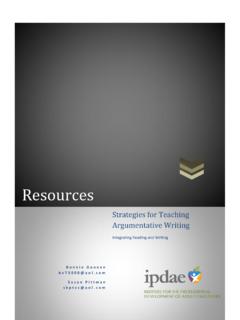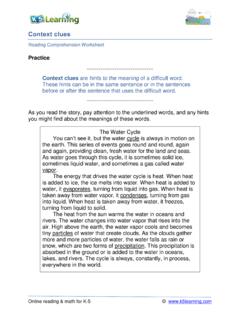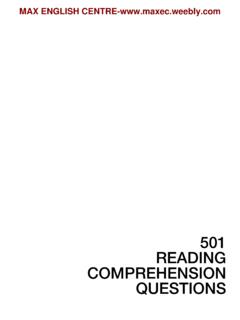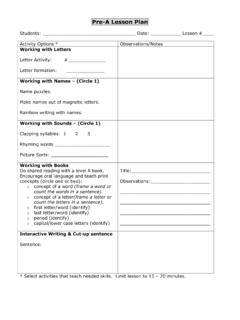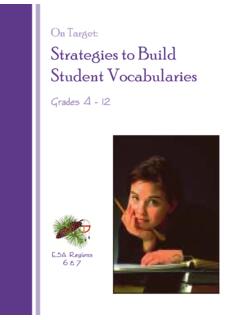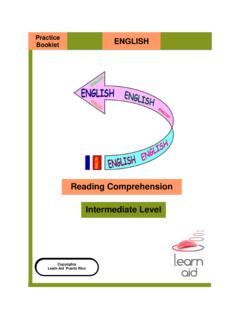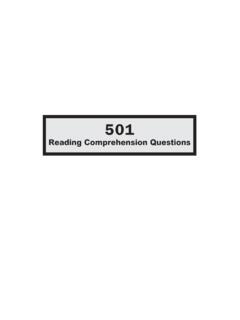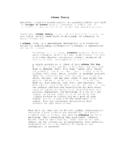Transcription of Lesson Title: Using Context Clues to Clarify the Meaning ...
1 Florida s Lesson Plans for ESOL Page 1 of 4 Module: reading (ESOL) Lesson Title: Using Context Clues to Clarify the Meaning of an Unknown Word Objectives and Standards Students will: Learn how to use Context to determine the Meaning of an unknown word or This Lesson supports the following standard(s): Determine or Clarify the Meaning of unknown and multiple- Meaning words and phrases, choosingflexibly from a range of strategies. Use Context ( , definitions, examples, restatements, cause/effect relationships and comparisons intext) as a clue to the Meaning of a word or Chart paper or board with markers Projector and screen (if not available, write the text/materials to be used on chart paper ornewsprint prior to the Lesson ) Index cards Sample text to read ( , newspaper or magazine article, medical pamphlet, electric/phone bill)Resources for Teachers For additional information on Using Context Clues , please see the following links.
2 Metacognitive Strategy Training for Vocabulary Learning: reading Skills for Success: A Guide to Academic Texts. (2004). Thomas A. Upton. The University of Michigan Press: Ann Arbor, Michigan. Types of Context Clues : Types of Context Clues and Strategies: Bloom s Taxonomy Revised: International reading Association. Florida s Lesson Plans for ESOL Page 2 of 4 Instructional Plan Note: Steps in this Lesson plan follow the explicit instruction model.
3 Please see for additional information about explicit instruction. Overview Language learners often struggle with the immense amount of vocabulary they need to learn. Knowing how to use Context Clues during reading can greatly improve students comprehension . In this Lesson , students will use Context to determine the initial Meaning of an unknown word or phrase. This Lesson should be taught in two-three initial lessons (approx. 40 minutes each) and then integrating continuous application and refresher lessons when needed. Process Step 1: Activating Background Knowledge Provide students with ample opportunities to reflect, early in the Lesson , on what they already know.
4 Write a sentence on the board with a word you think your students may not be familiar with, including a Context clue (the most accessible is the definition, so you may want to try that first. For example: Providing a job performance critique, or a detailed explanation of the problems, can be a difficult task. Underline the word critique and ask students what the word means. Elicit reasons why students believe the definition they provided is correct. After discussion, explain to students that what they were Using is called Context Clues . Ask students if they use Context Clues in their native language.)
5 Step 2: Explanation Provide explanations to students regarding the strategy they will be learning: why you are teaching them this skill, and how will it help them be successful language learners and college and career ready ( where will they encounter a need for this skill outside of the classroom). For example: When you come across a word you don't know, don t stop reading . You can often figure out the Meaning of an unfamiliar word by Using the words around it. The surrounding sentence or paragraph is known as the Context . By learning strategies of Using Context Clues , you can improve your vocabulary and comprehension .
6 This can help you in any type of reading you do: for work, school, tests, or in your personal life. You can also use these strategies when you are listening to the news, the radio or when someone is speaking to you. Some students may ask why not use a dictionary. Explain that they may not always have a dictionary handy, especially during a test, and even if they do have a dictionary, many words have multiple meanings and the students would still need to be able to use Context Clues to determine which Meaning is accurate. Florida s Lesson Plans for ESOL Page 3 of 4 During this Lesson , students will create a checklist (with support and guidance from the teacher) of the steps to take when trying to decide the Meaning of an unknown word.
7 There are four main types of Context Clues (definition, antonym, synonym, and inference). You may need to pre-teach some vocabulary, such as synonym or antonym, if students have not been exposed. However, you could do this Using Context clue instruction! If your students are not familiar with the strategy of Using Context Clues , it would be best to start with definition, antonym and synonym, while saving inference for a later time, such as after learners have mastered the use of basic Context Clues . Step 3: Modeling Model what you want students to be able to do.
8 For this strategy, it is best if you have access to a projector screen so you can save time by preparing ahead of time. If you do not have access to this, prewriting the text on newsprint will work. Using the same sentence as you used in the activating background knowledge (or a different one is fine too), provide four examples of Context Clues Using the same word. Engage in a think aloud, demonstrating how you are figuring out the Meaning of the unknown word, Using Context . Once you begin the third sentence, you can begin to elicit responses from students to see if they can provide additional methods or are familiar with ones you are suggesting.
9 Step 4: Practice Opportunities Students should be provided with ample practice opportunities so they can master the reading skill. Use previously taught vocabulary for this exercise. It s a great way to recycle important material while strengthening a new skill. Using index cards, write at least 3-5 previously learned vocabulary words per group. Groups shouldn t be larger than 4. Ask students to write sentences Using the vocabulary, but they must include a Context clue in each sentence. Students should indicate on the back of the card what type of Context clue they are Using (definition, synonym, antonym or inference).
10 Once each group completes the activity, have each student take one card and find a partner. The partner will have to read the sentence, provide a Meaning for the unknown word and determine what type of Context clue this is. Be sure to model the activity. Provide the class with a short reading from a newspaper or magazine. Prior to distributing the reading passage, underline 3-4 words. Have students work together Using the checklist to determine the Meaning . You can continue doing this throughout your classes, regardless of the text topic. Bring in copies of a medical pamphlet, electric/phone bill, and a town notice.
